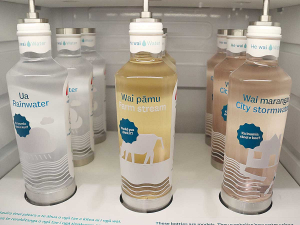Te Papa muddying the waters
Debate over Te Papa’s controversial exhibition on water quality has farmers continuing their criticism and the museum defending its stance.
 The Te Papa display showing artificially coloured water supposedly from different parts of the country.
The Te Papa display showing artificially coloured water supposedly from different parts of the country.
Museum of New Zealand, Te Papa Tongarewa has made no new friends in the dairy sector with its farcical display of water quality ‘samples’ from around the country.
The furore erupted a month ago after National MP Todd Muller tweeted a picture of a bottle of brown water, part of a display in the museum’s Te Taiao Nature exhibition.
The bottle featured an image of a cow defecating in a waterway and a map indicating the water was from the Waikato.
To their credit, Te Papa changed the label to show the cow standing on solid ground and no longer defecating. The map had also been removed and a note been added to the display to make it clear the bottles were not samples but only symbolic.
However, farmers are rightly asking how and why the Te Papa got it wrong in the first place?
It could have asked DairyNZ. After all, only days earlier they had hosted (and most likely charged NZ dairy farmers a hefty sum) a dinner for the annual Dairy Environment Leaders Forum to celebrate the great work dairy farmers had undertaken.
Farmers were upset the museum had used dyed brown water in the display, rather than taking an actual sample from a farm stream.
The display was an unfair body blow to the New Zealand farmers and the dairy sector, at a time when they are striving to win public support and recognition for the hard work they have done over the years to restore water quality on farms.
Farmers demanded to know when and where this water was taken from. Te Papa confessed that the water wasn’t actually from a farm at all but was made up in a back room using brown dye. It is clear that the water in their display is not representative of an average farm stream.
The group is also upset about how the bottle was labelled and how the sector was represented.
DairyNZ says the imagery on the bottle of a cow standing in water defecating is highly deceptive and entirely out of step with the reality of dairy farming in New Zealand today, “where we are proud to have fenced off 98.3% of waterways in recent years”.
“Farmers who have done the right thing and voluntarily invested their time and their money to fence off waterways and plant riparian strips deserve better than this from their national museum.”
Let’s hope Te Papa has learnt a lesson. Dairy farmers aren’t asking for much, they only seek credit for the good work done on farms around water quality.
New Zealand needs a new healthcare model to address rising rates of obesity in rural communities, with the current system leaving many patients unable to access effective treatment or long-term support, warn GPs.
Southland farmers are being urged to put safety first, following a spike in tip offs about risky handling of wind-damaged trees
Third-generation Ashburton dairy farmers TJ and Mark Stewart are no strangers to adapting and evolving.
When American retail giant Cosco came to audit Open Country Dairy’s new butter plant at the Waharoa site and give the green light to supply their American stores, they allowed themselves a week for the exercise.
Fonterra chair Peter McBride says the divestment of Mainland Group is their last significant asset sale and signals the end of structural changes.
Thirty years ago, as a young sharemilker, former Waikato farmer Snow Chubb realised he was bucking a trend when he started planting trees to provide shade for his cows, but he knew the animals would appreciate what he was doing.